Discus fish (lat. Symphysodon) is an incredibly beautiful fish with very unusual body shape. The discus fish is often called a king of freshwater tanks and not in vain. Large, impossibly bright fish with lots of different colorings… so why not a king? Discus is leisured and stately as the king should be. This peaceful and graceful fish draws aquarists’ eye like no other can.
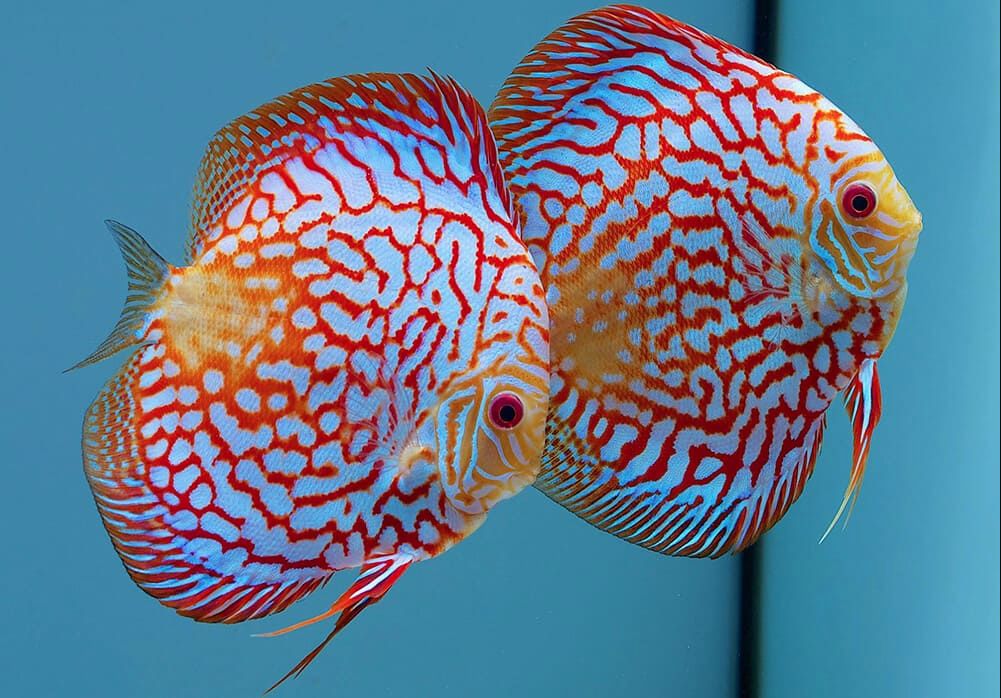
Contents
Habitat in the wild
Are discus cichlids? Sure.
Discus fish belong to the family Cichlidae, which is a diverse family of freshwater fish commonly known as cichlids. Within the Cichlidae family, the discus fish belong to the genus Symphysodon. There are currently three recognized types of wild discus fish:
- Symphysodon aequifasciatus Pellegrin, 1904 (blue discus or brown discus) – it is the most widespread species and has various color variations.
- Symphysodon discus Heckel, 1840 (red discus or Heckel discus) – it is highly sought after by hobbyists and is known for its distinct and vibrant coloration.
- Symphysodon tarzoo E. Lyons, 1959 (green discus) – it is relatively rare in the aquarium trade and exhibits a beautiful coloration.
Sure, nowadays wildlife species of discus fish are much less spread, than species obtained by selective breeding. In addition to these species, there are numerous color variations or strains of discus fish that have been selectively bred over the years. These strains are distinguished by their unique color patterns, which include solid colors, patterns, and combinations of various hues.
Each strain has its own distinct beauty and appeal, with variations in color intensity, pattern, and overall appearance. It’s important to note that these strains are not separate species but rather variations bred from the recognized species of discus fish. Selective breeding has allowed for a wide range of captivating discus fish colors and patterns that are highly sought after by aquarium enthusiasts.
Where do discus fish come from?
Discus fish are native to the Amazon River basin in South America. They are primarily found in the countries of Brazil, Peru, and Colombia. Within these regions, discus fish inhabit slow-moving rivers, flooded forests, and shallow oxbow lakes.
The Amazon River basin biotopes change substantially during a year: when the rainy season comes in December the Amazon River floods. Tropical showers and ice water from highlands increase water stage in the streamway. Lots of tributaries change their streamline into the opposite one, till the overflowing river doesn’t flood a huge territory.
Muddy and clayey water gets into the ponds with crystal clean water. The flooded forest that surrounds the Amazon River turns into one single slow flowing bog.
Rainstorms stop by May. The river water stops its ingress into the flooded forest and the water there gradually becomes clean and transparent. Since July and for several months later the water stage sufficiently decreases. A lot of separated waters and small streams appear, there the water becomes clean and obtains distinguishing dark color.
Water parameters in such basins can reach maximum softness values, become aseptic with no electroconductibility. According to H. Bleher discus fish inhabits in black waters among riverside bushes. The waters bottom is covered with rotten leaves. The water is very soft and rather acidic. Roots of the riverside plants are under the water most of the year and serve as a shelter and spawning substrate.
When the water stage lessens, the discus fish leaves its hide-places and swims to the depth closer to the basins center. Discus can’t be encountered in large rivers and very seldom it’s seen where the water flow is strong, it settles in lots of tributaries and streams.
Thus, limited migration of isolated populations leads to the formation of certain features (coloring, first of all) even for comparatively small isolated groups.
In the wild the basics of diet is insect larvae and freshwater prawn.
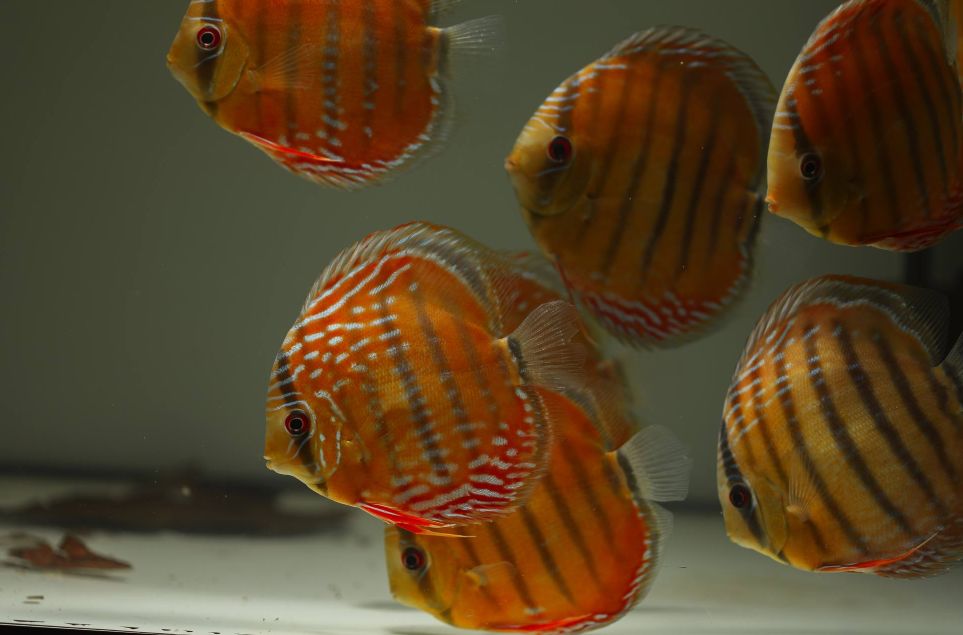
Description
This is one of the cichlids which has the most flattened body and it reminds a disc, which gave the discus fish its name. Right now it’s impossible to describe coloring, since there are lots of species with different coloring which were bred by the amateur aquarists. It’ll take quite a while just to try to name the types of the coloring.
However, in the process if selection this fish has not only got a bright coloring, but also rather weak immunity and liability to diseases. Unlike the wildlife species, selected species are more demanding and picky.
Even though this species has coloring that differs quite a lot from the wildlife species, it is less adapted to life in a tank, it prones to get ill more often and requires much more care. Moreover, discus is one of the most demanding tank fish, which requires stable water parameters, a spacious tank, quality feed and the fish itself isn’t a cheap one.
How big does a discus fish get?
Discus fish (Symphysodon spp.) generally reach an average size of 6 to 8 inches (15 to 20 centimeters) in diameter. However, factors such as genetics, diet, and overall care can influence their growth rate and ultimate size.
How fast do discus grow?
On average, it takes around 1 to 2 years for discus fish to reach their full size, which is typically between 6 to 8 inches (15 to 20 centimeters) in diameter. During the initial months, discus fry grow relatively quickly, and their growth rate is more noticeable. However, as they mature, their growth tends to slow down. Providing a nutritious and varied diet, maintaining optimal water conditions, and ensuring a stress-free environment can contribute to promoting healthy growth in discus fish.
It’s important to note that individual discus fish can have different growth rates even within the same group or batch. Additionally, some strains or varieties of discus may have different growth patterns or sizes due to genetic factors. Monitoring their growth and adjusting their diet and care accordingly will help support their development and ensure they reach their maximum potential size.
How long do discus live?
Discus fish have an average lifespan of around 8 to 10 years in captivity. With proper care, some discus fish have been known to live even longer, reaching 12 years or more. It’s worth mentioning that discus fish generally have a higher risk of health issues and are more sensitive to fluctuations in water parameters compared to some other freshwater fish species. Providing consistent and stable water conditions, regular maintenance, and attentive care will help promote the long and healthy life of discus fish.
| Characteristic | Description |
|---|---|
| Scientific Name | Symphysodon spp. |
| Origin | Amazon River basin in South America |
| Family | Cichlidae |
| Average Size | 6-8 inches (15-20 centimeters) |
| Lifespan | 8-10 years (can live longer with proper care) |
| Body Shape | Deep-bodied and laterally compressed |
| Color Varieties | Various color variations including blues, reds, and greens |
| Temperament | Generally peaceful but can be territorial during breeding |
| Water Temperature | 82-86°F (28-30°C) |
| pH Range | 6.0-7.0 |
| Water Hardness | Soft to slightly hard water (4-12 dGH) |
| Tank Size | Minimum of 50 gallons for a pair, larger for a community |
| Diet | Primarily carnivorous, requires high-protein diet |
| Tank Decoration | Plants, driftwood, and rocks to create hiding places |
| Water Filtration | Efficient filtration with regular water changes |
| Breeding Behavior | Caring for eggs and young fry, parents are dedicated |
| Common Health Issues | Stress-related diseases, discus-specific infections |
| Special Considerations | Require clean water and stable conditions for optimal health |
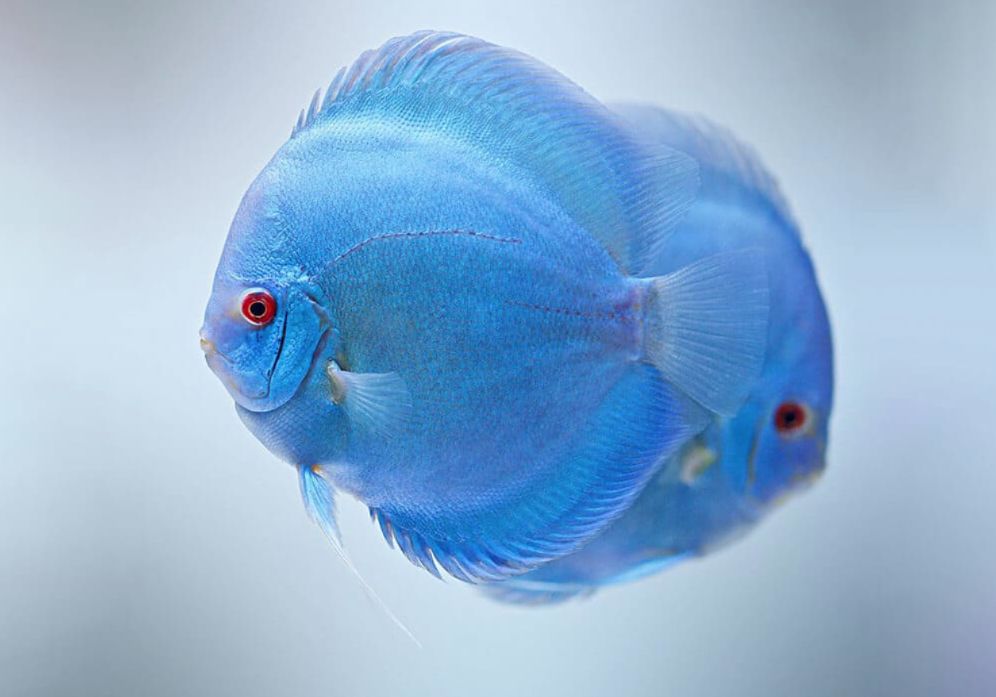
Are discus fish easy to keep?
No! Discus fish is definitely for experienced aquarists, it’s decidedly not the fish for the beginners. The discus fish is very demanding, so even for an expert aquarist it can be quite challenging to keep it, especially to make it breed.
The first difficulty owner faces is the discus fish acclimatization in a new tank. Adults takes its relocation more easily, yet even they are prone to get stressed.
Large sizes, ill health, demanding to care and feed, high tank water temperature – all these issues you have to consider before buying your first discus. You’ll need a spacious tank, a very good filter, branded food and huge amount of patience.
You have to be cautious when buying the discus fish, since it tends to get ill with white spot disease and others, and relocation will cause stress and stimulate the disease development.
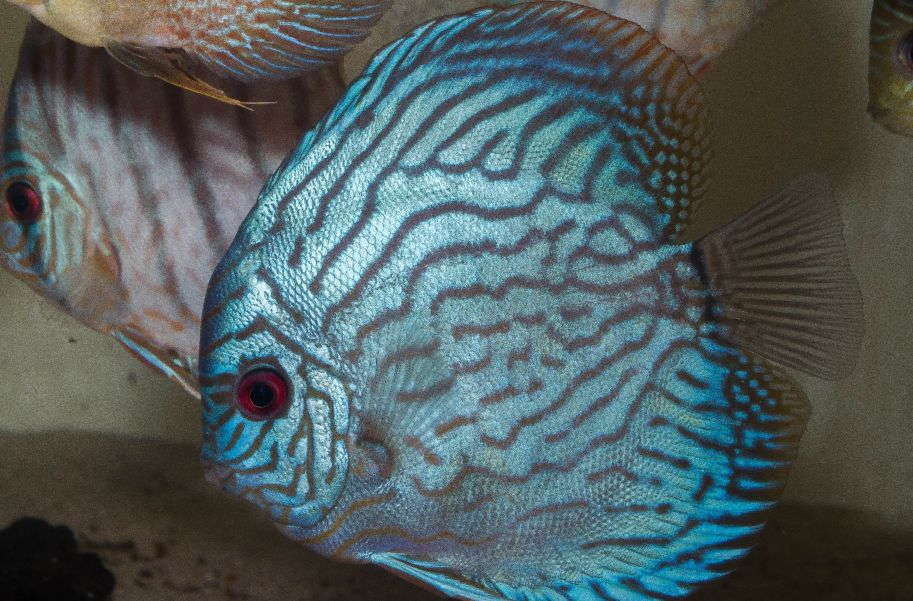
Diet
A high-quality, protein-rich pellet or flake food specifically formulated for discus fish can serve as a staple diet. Look for products that contain a variety of ingredients such as fish meal, shrimp meal, and spirulina. Feed small portions multiple times a day to prevent overfeeding and to accommodate their small stomachs.
Discus fish thrive on a diet that includes a variety of frozen or live foods. For example, tubifex, blood worm, brine shrimp, corethra, gammarus. These foods provide essential nutrients and mimic their natural diet. R
However, professional keepers feed it either with branded feed, or with different meat farce which include ox heart, prawns and mussels, fillet, nettle, vitamins, different vegetables. Almost any professional aquarist has its own proved recipe and sometimes it consists of dozens of ingredients. It’s important to keep in mind that discus is rather timid and a bit dumb; they can stay in some corner of the tank while the other fishes are eating.
This is the reason why this fish is usually kept separately from others.
We’d like to mention also that protein rich leftovers which get to the tank bottom cause growth of ammonia and nitrates content in the tank water, which takes a toll on fish. You should either siphonage the tank bottom regularly, or use no bottom substrate for the tank, which is often done by the aquarists.
However, especially live blood warm and tubifex may cause both different diseases and foodborne intoxication of the fish, that’s why the discus fish is usually fed with minced meat or artificial feed.
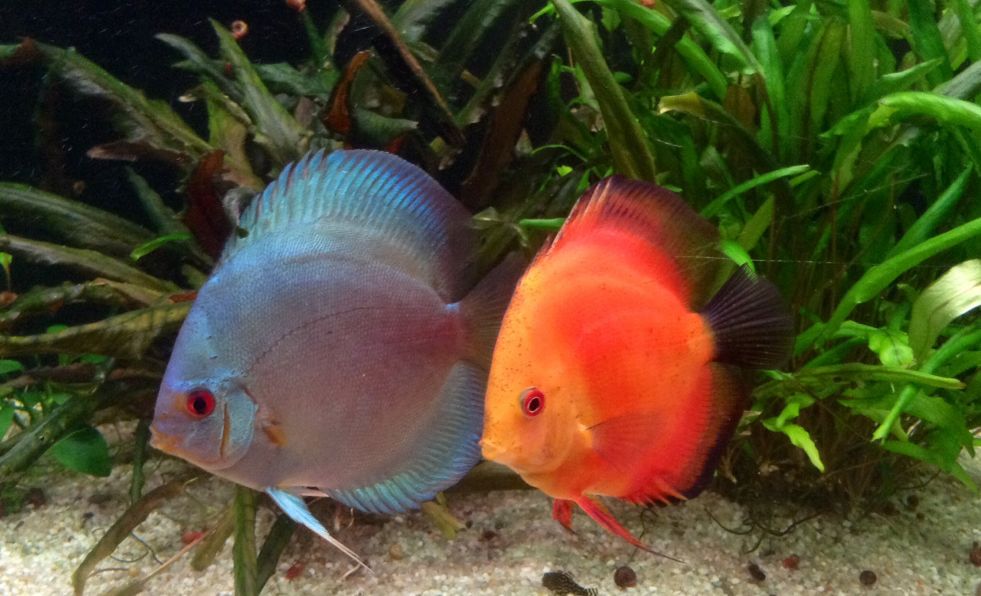
Discus fish care
Tank size
The recommended tank size for discus fish depends on various factors, including the number of discus fish you plan to keep, their size, and whether you want to have other tank mates. Here are some general guidelines for discus tank size:
- For a Pair of Discus: If you intend to keep a pair of adult discus fish, a minimum tank size of 50 gallons (190 liters) is recommended. This size allows for adequate swimming space and provides a suitable environment for a breeding pair.
- Community Tank: If you wish to keep a community of discus fish along with other compatible species, a larger tank is required. It is generally recommended to have a tank size of 75 gallons (285 liters) or more to accommodate multiple discus fish and provide sufficient territory for each fish.
- Schooling Discus: Discus fish are known to thrive in groups, and keeping a school of discus is a popular choice. For a group of discus fish, it is recommended to have a tank size of at least 100 gallons (380 liters) or larger. A larger tank provides more swimming space and reduces the risk of aggression among the fish.
Keep in mind that these recommendations provide a baseline for providing adequate space for discus fish. It’s always better to provide a larger tank whenever possible, as it allows for better water quality, easier maintenance, and reduces stress on the fish.
Water parameters
Discus fish are known to be sensitive to water parameters, and providing suitable water conditions is crucial for their health and well-being. Here are the recommended water parameters for discus fish:
- Tank water should be soft and a bit acidic, as for its temperature – the discus fish requires hotter water than the majority of tropical fish does. This is one of the reasons why it’s difficult to choose discus tank mates. Water temperature comfortable for the discus fish is between 82°F to 86°F (28°C to 30°C).
- The recommended pH range for discus fish is usually between 6.0 to 7.0.
- Discus fish prefer soft to slightly hard water. The recommended water hardness level for discus fish is typically between 4 to 12 degrees of General Hardness (dGH).
- Is very sensitive to ammonia and nitrates content in tank water, just like to all water parameters in general and its purity. Although, the discus fish itself doesn’t produce a lot of waste, it eats mainly different kinds of forcemeat which crumbles quite fast in tank water and this way pollutes it.
- In addition to specific parameters, maintaining overall water quality is crucial for discus fish. This includes regular water changes (around 20% to 30% weekly), mechanical and biological filtration, and removing any uneaten food or waste from the tank. Powerful external filter is a must in this case, the same is about regular tank bottom substrate siphonage and weekly partial water renew.
Tank decor
Discus fish is very timid – it doesn’t like loud sounds, sudden movements, knocking on the tank glass and restless tank mates. It’s desirable to place the tank with discus somewhere where it’ll be less disturbed.
Planted tanks will do for discus fish, if they have enough space to swim there. However, you have to consider that not all plants can stand water temperature higher than 28 °C, therefore it’s quite difficult to select proper plant kinds.
Here are the following options you may consider: Didiplis diandra, Vallisnéria, Anubias barteri var. nana, giant ambulia, rotala indica. Tank substrate can be of any kind, however, as a rule, the fish is kept in tanks with no plants or bottom substrate.
By doing this you make the process of taking care about the fish much easier and reduce a risk of the fish getting ill.
When you first put discus fish into a tank, give the fish some time to recover from stress. Don’t turn on the light, don’t stand near the tank, put some plants or something else into the tank, which the fish can use to hide.
Temperament
Discus fish are generally known for their peaceful temperament. They are not aggressive by nature and can coexist well with other calm and compatible tank mates. During breeding or when establishing a hierarchy, discus fish may exhibit territorial behavior. This can involve defending a specific area of the tank or becoming more aggressive towards other fish. It’s important to provide ample space and hiding spots to minimize territorial disputes.
Tank mates
Unlike other cichlid species discus is a peaceful and good tempered one. It’s not a predator and it doesn’t dig tank substrate like other cichlids. Discus is a schooling discus fish so it prefers to stay in groups of 6 species at least and it hardly stands being alone.
The difficulty when choosing tank mates for discus is that the fish is slow, it eats slow and inhabits in water with rather high for other species temperature. Due to this and also to prevent the possibility of the infection, fish is often kept in a separate tank.
But, if you still want to put some tank mates into the tank, you should consider the following:
- Many species of tetras, such as cardinal tetras, neon tetras, and rummy nose tetras, make good companions for discus fish. They are small, peaceful, and thrive in similar water conditions.
- Various species of Corydoras catfish, such as adolfoi corydoras or panda corydoras, are compatible with discus fish. They are bottom-dwelling, peaceful, and help keep the tank clean.
- Dwarf Cichlids: Some species of dwarf cichlids, such as German blue ram, can coexist with discus fish. However, it’s important to monitor their behavior as some dwarf cichlids can become territorial during breeding.
- Certain species of plecos, such as bristlenose plecos (Ancistrus sp.), can be suitable tank mates. Plecos are generally peaceful, and they help control algae growth in the tank.
- While angelfish (Pterophyllum scalare) are larger cichlids, they can be compatible with discus fish if they are introduced as juveniles and if there is enough space in the tank. Monitoring their behavior and providing suitable hiding spots is essential.
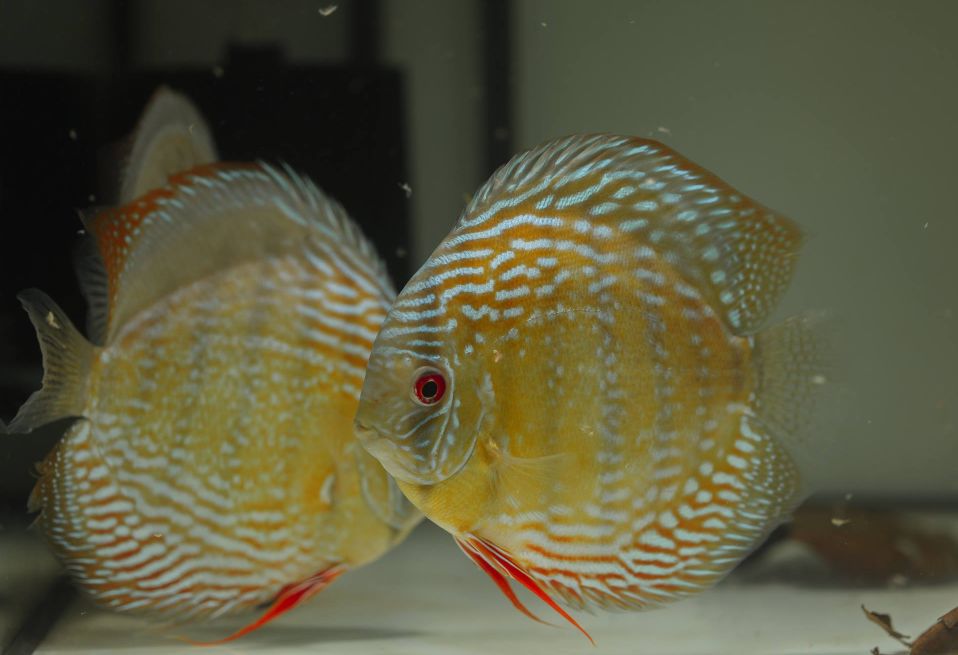
Gender differences: male vs female
It’s quite difficult to see between discus fish male and female, you can know for sure only during their spawning period. There are a few general characteristics that can help in distinguishing between males and females:
- Some experienced aquarists can distinguish the male from the female by its head – the male has more receding forehead and full lips.
- Adult male discus fish tend to be slightly larger than females. Males may have a more elongated and muscular body shape compared to females.
- In some strains or varieties, males may display more intense and vibrant coloration compared to females.
- During breeding, males are often more active, assertive, and territorial compared to females. Males may engage in courtship displays, establish territories, and exhibit more aggressive behavior.
Breeding
If you aim to make your discus breed, so the more species are in a school, the better. You should buy at least 6-8 young species and hope that in time you’ll get at least one couple among them.
There’s no need to interfere into the process of the couple formation – the discus fish will do it themselves.
However, it is desirable to prepare a proper sized tank for them in advance, since yesterday’s juveniles will turn into large fish quite fast. Prepare a separate spawning tank in advance as well.
What should I do if couple eats its eggs? This is quite common phenomena when discus breeding and it is often observed among the young discus fish. Don’t hurry to break up the couple. It’s better to give it a chance to grow older.
You have to let them show themselves as “parents”, usually after several unsuccessful spawning everything gets fine. You may also use a glass wall or some net to separate from the others the parent, who usually eats the eggs.
Or you can cover the spawn with some synthetic net, through which the juveniles will be able to go out later.
However, in this case the discus fish parents may completely lose their interest to the eggs. If nothing of these helps, then you should break up the couple after their 10-15 tries to spawn.
Should I continue tank water renews when the discus fish has already spawned?
For successful discus fish breeding water in the spawning tank should be very clean. If there is a possibility, stick to the routine schedule of water renews. Especially if the spawning tank is small sized (about 100 liters or 26,42 gallons).
We can recommend you to continue water renews but in smaller amounts and more often. Surely, the spawning tank water parameters must be the same as the initial tank water has. In fact, this condition is rather difficult to fulfill. That’s why lots of professional breeders prefer to stop water renews in the spawning tank for some time.
Light in the spawning tank should be dim, but it should be on 24 hours a day during spawning. Any low powered lamp placed at some distance from the spawning tank will do for this purpose.
We’d also like to remind you not to disturb the fish in the spawning tank by any other unnecessary actions inside it.
Water in the spawning tank has to be maximally soft (2-3 degrees) and slightly acidic (pH in the range of 6-6,2). In more hard and alkaline water the percentage of fertilized eggs significantly reduces.
When pH value changes to more acidic one (close to 5.5), increase of the fish phys secretion was noticed. However, a list of other issues arises then.
Also there are known the cases of some species breeding in common tap water.
Actually, we still don’t know for sure what causes unsuccessful spawning of discus. Sometimes in water which is proper for the discus fish spawning the results are rather doubtfully successful and vice versa, – in quite old water with large amount of organic wastes in it, with definitely not proper parameters one achieves 100 % juveniles yield.
Any attempt to reproduce this success usually gives zero result.
One of the criteria to make this or that decision as for the water renews is the spawning tank size, where the fish has laid its eggs. In case of large sized spawning tank you have some spare space, which can be used.
If the spawning tank is small, it’s obvious that the water will get spoiled faster and it’ll surely require renews.
So more difficult it is to perform renews in this case without changing the water parameters in the end. And the latter affects adversely the eggs and larvae.
From all these sketchy facts, that don’t cover completely all the issues as for breeding, it becomes obvious how complicated the whole process is and why it still does not happen simple and easy on an industrial scale.
Even in large Asian farms, where there are lots of tanks with discus with the same water parameters, still each couple requires custom solutions.